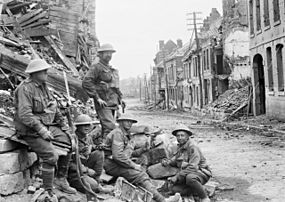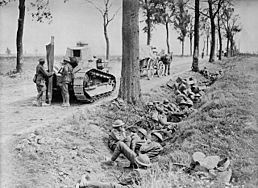Hundred Days Offensive facts for kids
Quick facts for kids Hundred Days Offensive |
|||||||
|---|---|---|---|---|---|---|---|
| Part of the Western Front of World War I | |||||||
 Allied gains in late 1918 |
|||||||
|
|||||||
| Belligerents | |||||||
| Commanders and leaders | |||||||
| Strength | |||||||
| Strength on 11 November 1918: |
Strength on 11 November 1918: |
||||||
| Casualties and losses | |||||||
| 18 July – 11 November: 1,070,000 |
18 July – 11 November: ~100,000+ killed 685,733 wounded 386,342 captured 6,700 artillery pieces Breakdown
Men and materiel captured, by country
2,500 killed 5,000 captured 10,000 wounded |
||||||
The Hundred Days Offensive (also known as the Grand Offensive or Canada's Hundred Days) was the final period of World War I, where the Allies launched a series of offensives against the Central Powers on the Western Front from 8 August 1918 to 11 November 1918, beginning with the Battle of Amiens. The offensive led to the final demoralisation and retreat of the German armies and the end of World War I. The Hundred Days Offensive does not refer to a specific battle or unified strategy, but rather the rapid sequences of Allied victories starting with the Battle of Amiens.
Background
The great German offensives on the Western Front beginning with Operation Michael in March 1918 had petered out by July. The Germans had advanced to the Marne River but failed to achieve a decisive breakthrough. When Operation Marne-Rheims ended in July, the Allied supreme commander, the French Marshal Ferdinand Foch, ordered a counter-offensive which became the Second Battle of the Marne. The Germans, recognising their untenable position, withdrew from the Marne towards the north.
Foch considered the time had arrived for the Allies to return to the offensive. The Americans were now present in France in large numbers, and their presence invigorated the French armies. Their commander, General John Pershing was keen to use his army in an independent role. The British Army had also been reinforced by large numbers of troops returned from campaigns in Palestine and Italy, and large numbers of replacements previously held back in Britain by Prime Minister David Lloyd George.
Foch agreed on a proposal by Field Marshal Douglas Haig, the commander of the British Expeditionary Force (BEF), to strike on the Somme, east of Amiens and southwest of the 1916 battlefield of the Battle of the Somme. The Somme was chosen as a suitable site for the offensive for several reasons. As in 1916, it marked the boundary between the BEF and the French armies, in this case defined by the Amiens-Roye road, allowing the two armies to cooperate. Also the Picardy countryside provided a good surface for tanks, which was not the case in Flanders. Finally, the German defences, manned by the German Second Army of General Georg von der Marwitz, were relatively weak, having been subjected to continual raiding by the Australians in a process termed Peaceful Penetration.
Battles
Amiens
The Battle of Amiens opened on 8 August 1918, with an attack by more than 10 Allied divisions — Australian, Canadian, British and French forces — with more than 500 tanks. Through careful preparations, the Allies achieved complete surprise. The attack, spearheaded by the Australian Corps and Canadian Corps of the British Fourth Army, broke through the German lines, and tanks attacked German rear positions, sowing panic and confusion. By the end of the day, a gap 24 kilometres (15 mi) long had been created in the German line south of the Somme. The Allies had taken 17,000 prisoners and captured 330 guns. Total German losses were estimated to be 30,000 on 8 August, while the Allies had suffered about 6,500 killed, wounded and missing. The collapse in German morale led Erich Ludendorff to dub it "the Black Day of the German Army".
The advance continued for three more days but without the spectacular results of 8 August, since the rapid advance outran the supporting artillery and ran short of supplies. During those three days, the Allies had managed to gain 19 kilometres (12 mi), but most of that had occurred on the first day, as a result of the Germans adding reinforcements. On 10 August, the Germans began to pull out of the salient that they had managed to occupy during Operation Michael in March, back towards the Hindenburg Line.
Somme
On 15 August 1918, Foch demanded that Haig continue the Amiens offensive, even though the attack was faltering as the troops outran their supplies and artillery, and German reserves were being moved to the sector. Haig refused, and instead he prepared to launch a fresh offensive by the British Third Army at Albert, which opened on 21 August.

The offensive was a success, pushing the German Second Army back over a 55 kilometres (34 mi) front. Albert was captured in 22 August. On 26 August, the British First Army widened the attack by another 12 kilometres (7 mi). Bapaume fell on 29 August. As artillery and munitions were brought forward, the British Fourth Army also resumed its offensive, and the Australian Corps crossed the Somme River on the night of 31 August, breaking the German lines at Mont St Quentin and Péronne. The British Fourth Army's commander, General Henry Rawlinson, described the Australian advances of 31 August–4 September as the greatest military achievement of the war.
By 2 September, the Germans had been forced back close to the Hindenburg Line, from which they had launched their offensive in the spring.
Hindenburg Line
Foch now planned a great concentric attack on the German lines in France (the Grand Offensive), with the various axes of advance converging on Liege in Belgium.
The main German defences were anchored on the Hindenburg Line, a series of defensive fortifications stretching from Cerny on the Aisne River to Arras. Before Foch's main offensive was launched, the remaining German salients west and east of the line were crushed at Havrincourt and St Mihiel on 12 September; and at Epehy and Canal du Nord on 18 September.
The first attack of Foch's Grand Offensive was launched on 26 September by the American Expeditionary Force in the Meuse-Argonne Offensive. Two days later, the Army Group under Albert I of Belgium (the Belgian Army and the British Second Army under General Herbert Plumer) launched an attack near Ypres in Flanders (the Fifth Battle of Ypres). Both attacks made good progress initially but were then slowed by logistic problems, particularly in the American sector.
On 29 September, Haig launched the main attack on the Hindenburg Line (the Battle of St. Quentin Canal) by the British 4th Army. By 5 October, the British Fourth Army had broken through the entire depth of the Hindenburg defences. Rawlinson wrote, "Had the Boche [Germans] not shown marked signs of deterioration during the past month, I should never have contemplated attacking the Hindenburg line. Had it been defended by the Germans of two years ago, it would certainly have been impregnable…"
Meanwhile (on October 8), led by the Canadian Corps, the 1st and 3rd British armies broke through the Hindenburg Line at the Battle of the Canal du Nord.
This collapse forced the German High Command to accept that the war had to be ended. The evidence of failing German morale also convinced many Allied commanders and political leaders that the war could be ended in 1918. (Previously, all efforts had been concentrated on building up forces to mount a decisive attack in 1919.)
German retreat
Through October the German armies were forced back through the territory gained in 1914, but their retreat never turned into a rout. However, the Allies were pressing the Germans back towards the lateral railway line from Metz to Bruges (shown in the map at the head of this article), which had supplied their entire front in Northern France and Belgium for much of the war. As the Allied armies reached this line, the Germans were forced to abandon increasingly large amounts of heavy equipment and supplies, further reducing their morale and capacity to resist.
Casualties remained heavy in all of the Allied fighting forces, as well as in the retreating German Army. Rearguard actions were fought at Ypres, Kortrijk, Selle, Valenciennes, the Sambre and Mons, with fighting continuing until the last minutes before the Armistice took effect at 11:00 on 11 November 1918. One of the last soldiers to die was Canadian Private George Lawrence Price, two minutes before the armistice took effect. The final soldier to die was American Henry Gunther, who died at 10:59 a.m., less than 60 seconds before the Armistice took effect.
Images for kids
-
Troops of the Royal Inniskilling Fusiliers, 36th (Ulster) Division, advancing from Ravelsburg Ridge to the outskirts of Neuve Eglise, 1 September 1918
See also
 In Spanish: Ofensiva de los Cien Días para niños
In Spanish: Ofensiva de los Cien Días para niños





